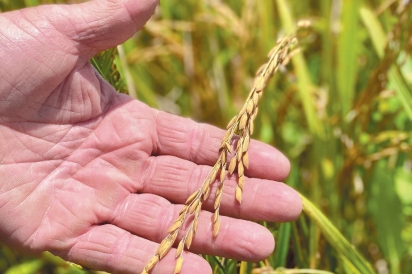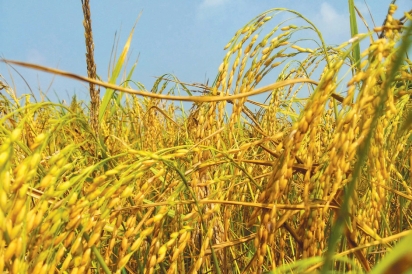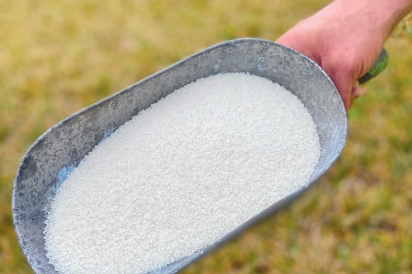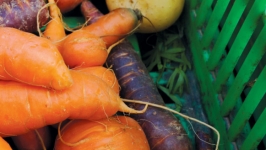Rice Farming In Texas - Harvest Grain Mills Grows Organic Heirloom Varieties
Heirloom rice varieties hold promise for Texas farmers
From Asia to Africa to the Gulf Coast, rice has long been the lifeblood of many cuisines. Evidence points to rice first being domesticated several thousand years ago along China’s Yangtze River. Over those millennia, that species (Oryza sativa) and an independently domesticated African variety (Oryza glaberrima) have been grown by millions, nurtured billions and evolved into multiple landraces, or locally adapted varieties.
David Kirkham, co-owner of Harvest Grain Mills, stands at the 21st-century tip of that history. He started farming rice when he was a high school senior. In the spring of 1972, his father, who began farming in 1947, planted 80 acres of rice for Kirkham. When school was out, he tended the fields and in the fall he harvested. The money he made paid his college tuition.
Rice farming in Texas has changed since then. Land is harder to find. Costs have increased while, according to Kirkham, profits per pound for conventionally grown rice have stagnated. To make a living farmers need to farm more acres or look to new varieties, methods and markets.
Now Kirkham, along with his cousin Donald Wilcox, grows, harvests and mills several hundred acres of organic Carolina Gold and
Charleston Gold rice in Anahuac east of Houston. Carolina Gold—or “Gold Seed,” as it was known until the early 1900s—was likely introduced to what became the United States in 1685, when a damaged ship sailing from Madagascar arrived in Charleston, South Carolina. The captain traded Dr. Henry Woodward rice seed for repairs. Woodward planted the seeds. It is one of the first recorded rice cultivations in the future United States. There is debate about that story’s accuracy, but we do know that by the end of the American Revolution Carolina Gold was becoming the primary rice grown throughout the southern Atlantic coast. By the 1850s, it was the foundation of a Southern cuisine rooted in West African foodways— and it was being grown in Louisiana and Texas.
Carolina Gold’s success relied heavily on the knowledge and labor of enslaved Africans, primarily from West Africa’s rice-growing regions. It was a vicious cycle. The plantation owners’ continued profits required more and more enslaved Africans to work in the brutal, labor-intensive antebellum rice industry. After the Civil War, South Carolina’s commercial rice farming began to decline. Having to pay for labor, it was difficult to compete with other rice growing regions. Carolina Gold’s commercial viability was dealt a final blow in 1911, when a hurricane devastated South Carolina’s rice fields. That same year, the rice companies that would become Houston-based Riviana Foods were founded. Its blander, more convenient white rice would dominate America’s 20th-century grocery aisles.
In the mid-1980s, Dr. Richard Schulze, an optometrist curious about the legendary rice-fed Carolina ducks he’d read about, acquired archived Carolina Gold seeds from the USDA Rice Research Unit in Beaumont, Texas, and successfully grew them in South Carolina. Expanding on Schulze’s work, Glenn Roberts, owner of heritage grain purveyor Anson Mills, began growing it for commercial use in 1998. A friend of Kirkham and former employee at the Beaumont research facility worked for Anson Mills and introduced the cousins to Roberts. In 2016, they contracted with Roberts to grow Carolina and Charleston Gold.
Kirkham explained that one of the characteristics of Carolina Gold is “it grows really tall, so down here on the coast when we get a little rain and wind, it blows down and you can’t cut it.” Charleston Gold solved that problem. At the USDA’s Beaumont Research Unit, Dr. Anna Mc- Clung spent 11 years developing this new variety by crossing Carolina Gold with a short-stalked variety and an aromatic landrace. “It has some aromatic properties and it grows shorter,” says Kirkham.
To sell to Anson Mills, the cousins, who also grow conventional rice, began growing several hundred acres organically. Initially, Anson bought and milled all their organically grown rice, but they began producing more than Roberts needed. So the cousins decided to mill the excess and sell both Gold varieties directly to consumers via Urban Harvest Saturday Farmers Market and their website; to small retailers such as Henderson & Kane, Local Foods and Central City Co-op; and to restaurants like UB Preserv and Pondicheri. One of their largest customers is New York’s FIELDTRIP, a three-restaurant mini-chain focused on global rice cuisines that is operated by Chef JJ Johnson, who won a James Beard Award for his cookbook Between Harlem and Heaven.
Growing high-quality organic rice is not easy. One key is precision grading of the fields using a laser level before planting in the spring. This allows for better land stewardship and water management. “You try to keep it as shallow as you can but keep all the grass and ground covered with water,” says Kirkham. The water kills the weeds but if it’s too deep the rice drowns or it will grow only one rice-producing shoot. “But if you keep the water shallow the seeds will put out other shoots from the bottom that will make more rice,” says Kirkham.
Once the fields are prepared, the rice is sown directly into the soil, which is more efficient than using an airplane to fly the seed onto flooded fields, which is what Kirkham’s dad did. A lot of that seed was lost to roads, canals and birds.
It takes 120 to 140 days for rice to mature; during that time farmers primarily manage water levels. Kirkham tries to harvest in August or early September, before he’s “deep into hurricane season,” since the storms can destroy a rice crop. Once the grain is harvested, it’s dried then milled.
“Then a month or two later, October or November, we’re trying to work the ground for next year. It’s a continuous cycle,” says Kirkham.
Despite the extra work and lower per-acre yield of organic methods, Kirkham thinks that in the face of global competition organics may be the future of Texas rice farming. “On the conventional side, you aren’t really getting more money for your rice than you were 20–30 years ago,” he says. “There’s no cost-of-living increase built into that. So it’s tough.” He makes 10 to 11 cents per pound on conventional, but nets 50 cents a pound on organic, if he can find a market for it. In the coming months, he plans to concentrate on increasing that customer base.
Those efforts could help future Texas farmers. Though technology has increased efficiency and yields, the number of rice farms has decreased while the size of farms has increased, leading to fewer farmers.
“If new farmers have to come from existing farmers, then this is going to be tough,” says Kirkham—especially when land is difficult to find and initial equipment costs hundreds of thousands of dollars. Banks are reluctant to loan to new farmers. But growing specialty varieties and organically could improve prospects for future Texas rice farmers.









